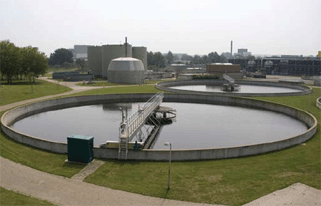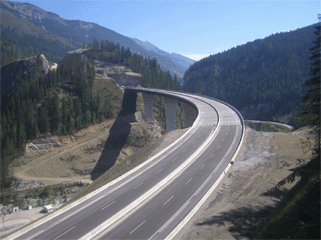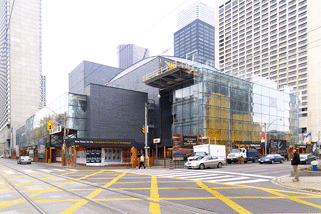Building Canada - Modern Infrastructure for a Strong Canada - Building Canada: the Plan - Building Better Communities
Building Canada: the Plan
Building Better Communities
Building Canada will promote strong, sustainable, competitive and livable Canadian communities through investments in critical infrastructure.
Drinking Water

Water treatment plant
Canada has more than one-quarter of the world's freshwater reserves, but even in a country as "water-rich" as Canada, there are challenges associated with the quality and supply of water. Many urban centres and rural areas need more and better water treatment systems so they can provide safe drinking water to their citizens. Rapidly growing cities face increasing pressure on their potable water sources, and many rural and remote areas that rely on wells have water quality problems.
Water conservation is also a problem, as many areas in Canada now experience seasonal water shortages. Still, Canadians pay some of the lowest water rates in the world and are amongst the highest water users. Investments in water infrastructure, supported by improved metering and effective pricing, will help reduce water consumption and protect fresh water supplies.
Building Canada promotes long-term funding for water infrastructure projects designed to:
- Improve the safety, management, reliability and efficiency of Canada's drinking water treatment and distribution systems;
- Increase the number of households with access to safe drinking water that meets or exceeds the Guidelines for Canadian Drinking Water Quality;
- Improve protection and management of drinking water sources;
- Improve conservation of water.
In August 2005, the Greater Toronto Area was hit with the most expensive natural catastrophe in Ontario history, the second most costly ever for the country. Heavy rains breaching the 100-year event level washed away infrastructure, flooded basements, and damaged cars with falling trees and rising flood waters. Also two tornadoes set down in the Salem/Fergus, Ontario area, damaging several properties. All in all, the event caused more than $500 million in insured losses.
Disaster Management, Vol. 1, Issue 2, summer 2007
Disaster Mitigation
Canada needs to protect its critical infrastructure assets from adverse climate change and ensure communities continue to provide vital services when natural disasters occur.
One-third of Canadians live in areas likely to experience natural disasters, ranging from floods and earthquakes, to hail and landslides.18 And these can have an immediate and widespread impact on transportation systems, electricity and telecommunications networks, water treatment systems and critical public facilities such as hospitals.
Climate change is expected to increase the frequency and magnitude of many of these natural disasters, and this will inevitably affect Canada's infrastructure. It could also necessitate the need to design, build and maintain our infrastructure differently to adapt to future changes. The country has already experienced a rise in mean temperature, heavier rainfalls and more severe winter storms. And these changes are all projected to accelerate over time.
Building Canada investments will be directed towards projects that will reduce the vulnerability of a community or public infrastructure to the negative impacts of extreme natural events, including adverse events related to climate change.
Brownfield Redevelopment
"Left idle and unmanaged, brownfields represent a significant loss of economic opportunity. They adversely impact a neighbourhood's image and quality of life, and in some cases pose risks to human health and the environment. Brownfields also represent an untapped opportunity to revitalize older neighbourhoods and generate wealth for communities."
National Roundtable on the Environment and the Economy, Cleaning Up the Past, Building the Future: A National Brownfield Redevelopment Strategy for Canada, February 2003
The redevelopment of brownfields – abandoned, or underutilized commercial or industrial sites - offers many potential community benefits, including affordable housing and new sources of economic activity. Redevelopment of these sites into higher-density, livable spaces can also provide an alternative to urban sprawl.
There are, however, barriers to brownfield development. One key challenge is that it is difficult for would-be developers to gain access to capital in the early stages due to environmental liability risks. Public investments in brownfields can help address such barriers.
Dockside Green (Victoria, BC) –From brownfield to a green community
The Dockside Green project has already won numerous awards in the fields of architecture, brownfield redevelopment and urban design. The project, which includes federal financial support through the Federation of Canadian Municipalities' Green Municipal Fund, will reclaim and redevelop a 12-acre former industrial waterfront property on land previously owned by the City of Victoria, situated in the heart of the city. Development will include light industrial, commercial (office and retail) and residential spaces, to be built between 2006 and 2014. Beyond mixed land uses, the project seeks to achieve social diversity (including social housing and housing for seniors) and to build an ecological community - one that uses biomass energy co-generation and which is greenhouse gas neutral. In fact, developers have a goal to create "North America's greenest community".
Building Canada investments will be directed towards projects designed to contribute to:
- The removal or neutralization of the negative effects of brownfields on communities and the environment by remediating and redeveloping these properties in a sustainable manner;
- More intense land use within cities and communities.
Roads and Bridges

Photo: BC Department of Transport
Kicking Horse Canyon Project, BC
Many municipal roads and bridges are in need of repair, and left unattended, this could compromise safety and efficiency. Older bridges, in particular, raise serious safety concerns and require prompt attention. Additionally, where municipal roads and regional highways are poorly designed, traffic congestion and longer travel times are likely.
Building Canada will support investments in road and bridge infrastructure projects that can:
- Improve transportation safety and efficiency;
- Improve mobility through removal of bottlenecks and reduced congestion;
- Minimize environmental impacts.
Sports and Culture
Many of Canada's sports facilities were built decades ago and are in need of repair or replacement. As populations grow, key regional communities face a shortage of sports venues. New or improved sports infrastructure will enhance access and promote sport and physical activity. Moreover, Canada can further promote healthy lifestyles by developing policies that encourage active modes of transportation and healthy community and infrastructure design.

Canadian Opera Company – Four Seasons Centre, Ontario
Culture creates dynamic cities and communities and helps promote and sustain Canada's rich multicultural heritage. Cultural infrastructure, such as museums, theatres, and art galleries, provides the venues for citizen engagement and participation in artistic and cultural activities that help define a community. Cultural industries also generate economic activity and attract skilled workers and tourists to a community. In 2004, the cultural sector was estimated to comprise 3.1 percent of the total labour force in Canada.19 Moreover, the contribution of cultural industries to provincial GDPs and employment is significant in Ontario and Quebec, and it is growing rapidly in British Columbia and Alberta.20
Building Canada offers support for sports and culture infrastructure projects providing significant regional or economic benefit that can:
- Provide increased opportunities for sport activities that can improve the health of Canadians and strengthen Canadian communities;
- Provide increased opportunities for the development of Canadian athletes and/or the hosting of major amateur athletic events;
- Support arts and/or heritage facilities;
- Help communities express, preserve, develop and promote their culture and/or heritage within Canada.
[18] Public Safety Canada, Keeping Canadians Safe.
[19] Culture Human Resources Council, Canada's Cultural Sector Labour Force, 2004.
[20] Statistics Canada, Economic Contribution of the Culture Sector in Canada: A Provincial Perspective, December 2004.
- Date modified: